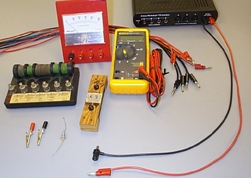Categories: Featured Articles » Novice electricians
Number of views: 39423
Comments on the article: 0
"Everything flows", or Ohm's Law for the curious
 Even the last loafer, having studied for some time in the 10th grade, will tell the teacher that Ohm's law - this is “U is equal to I times R”. Unfortunately, the smartest excellent student will say little more - the physical side of Ohm's law will remain a mystery to him for seven seals. I allow myself to share with my colleagues my experience in presenting this seemingly primitive topic.
Even the last loafer, having studied for some time in the 10th grade, will tell the teacher that Ohm's law - this is “U is equal to I times R”. Unfortunately, the smartest excellent student will say little more - the physical side of Ohm's law will remain a mystery to him for seven seals. I allow myself to share with my colleagues my experience in presenting this seemingly primitive topic.
The object of my pedagogical activity was the art and humanitarian 10th grade, whose main interests, as the reader guesses, lay very far from physics. That is why the teaching of this subject was entrusted to the author of these lines, who, generally speaking, teaches biology. It was a few years ago.
The lesson about Ohm's law begins with the trivial statement that electric current is the movement of charged particles in an electric field. If only an electric force acts on a charged particle, then the particle will accelerate in accordance with Newton’s second law. And if the vector of electric force acting on the charged particle is constant on the entire trajectory, then it is equally accelerated. Just like a weight falls under the influence of gravity.
 But here the paratrooper drops completely wrong. If we neglect the wind, then its fall rate is constant. Even the student of the art and humanitarian class will answer that in addition to the force of gravity, another falling force acts on the falling parachute - the force of air resistance. This force is equal in absolute value to the force of attraction of the parachute by the Earth and is opposite to it in direction. Why? This is the key question of the lesson. After some discussion, we conclude that the drag force increases with increasing fall rate. Therefore, the falling body accelerates to a speed at which gravity and air resistance equalize, and the body further falls at a constant speed.
But here the paratrooper drops completely wrong. If we neglect the wind, then its fall rate is constant. Even the student of the art and humanitarian class will answer that in addition to the force of gravity, another falling force acts on the falling parachute - the force of air resistance. This force is equal in absolute value to the force of attraction of the parachute by the Earth and is opposite to it in direction. Why? This is the key question of the lesson. After some discussion, we conclude that the drag force increases with increasing fall rate. Therefore, the falling body accelerates to a speed at which gravity and air resistance equalize, and the body further falls at a constant speed.
True, in the case of a paratrooper, the situation is somewhat more complicated. The parachute does not open immediately, and the paratrooper accelerates to a significantly higher speed. And when the parachute has already opened, the fall begins with a deceleration, which continues until the force of gravity and the force of air resistance are balanced.
For a parachute cargo with a total mass m descending at a constant speed v, we can write: mg - F (v) = 0, where F (v) Is the air resistance force, considered as a function of the rate of fall. Regarding the form of the function F (v) we can say only one thing so far: it is growing monotonously. It is this circumstance that provides stabilization of speed.
In the simplest case, when F (v) = k, the constant speed with which the parachute will fall will be equal to mg / k. Let's do some conversion now. Let the parachute fall from a height h. Then the difference in the potential energies of the body before and after the fall will be equal to mgh = mU, where U is the potential energy of a body of unit mass at a height h, or the potential difference of the gravitational field at the initial and final points of incidence.
In view of the foregoing, we obtain the formula: F (v) = mU / h. (1)
And now back to the conductor through which electric current flows. A large number of charged particles move along the conductor, which collide with atoms more often the faster they fly. The analogy with the descent of a parachute is quite transparent, the only difference is that there are a lot of “parachutes” and they move not in the gravitational, but in the electric field. Given these circumstances, (1) can be rewritten in the form: F (v) = eU / l, (2)
where e is the particle charge, U is the electric potential difference at the ends of the conductor, l is the length of the conductor.The current strength is obviously equal to I = neS, where n is the number of charged particles per unit volume, S is the cross-sectional area of the conductor, is the particle velocity (for simplicity, we assume that all charged particles are the same).
To obtain the dependence I (U), you need to know explicitly the dependence F (). The simplest option (F = k) immediately gives Ohm's law (I ~ U):

The value is called conductivity, and the reciprocal of it is called resistance. In honor of the discoverer of the law, resistance is usually expressed in ohms.
The value (ne2 / k) is called the specific conductivity, and its inverse value is called the specific resistance. These values characterize the material of which the conductor consists. It is significant that the conductivity is proportional to the number of charged particles per unit volume (n). In metals and electrolyte solutions, this number is large, but in dielectrics it is small. The number of charged particles per unit volume of a gas can depend on the applied field (i.e., it is a function of U); therefore, the Ohm law does not apply to gases.
In deriving Ohm's law, we made one non-obvious assumption. We accepted that the force inhibiting the movement of a charged particle is proportional to its speed. Of course, one could try to justify this idea somehow, but the experimental verification looks much more convincing.
An experimental verification of this assumption is, obviously, a verification of Ohm's law itself, i.e. proportionality of U and I. It would seem that this is not difficult to do: we have a voltmeter and an ammeter! Alas, everything is not so simple. We have to explain to our students that a voltmeter, just like an ammeter, measures not voltage, but current strength. And we have the right to set volts on the voltmeter scale only because we initially know Ohm's law, which we want to check. Need other approaches.
You can, for example, use the following idea. We connect n batteries in series and assume that the voltage in this case increased n times. If Ohm's law is true, then the current strength will also increase n times, because of which the ratio n / I (n) will not depend on n. This assumption is justified by experience. True, the batteries also have internal resistance, which is why the value of n / I (n) grows slowly with increasing n, but it is not difficult to correct for this. (G. Ohm himself measured stress in a different way, which students can read about in the textbook of G.Ya. Myakishev and others.)
We ask the question: ““ In the distant constellation of Tau Ceti, ”not Ohm’s law, but the law of the great local scientist Academic X. According to X's law, the current strength is proportional to the square of the potential difference at the ends of the conductor. How does the braking force of particles depend on their speed on the Tau Ceti? ” With the help of simple transformations, students come to the conclusion that the force is proportional to the square root of speed.
 And now let's move on to another process: the movement of water in a pipe, at the ends of which different pressures are created. Here we have a completely different situation: not separate moving particles rub against a stationary material distributed throughout the entire volume of the conductor, but layers of moving particles rub against each other. And this circumstance fundamentally changes all physical reasoning.
And now let's move on to another process: the movement of water in a pipe, at the ends of which different pressures are created. Here we have a completely different situation: not separate moving particles rub against a stationary material distributed throughout the entire volume of the conductor, but layers of moving particles rub against each other. And this circumstance fundamentally changes all physical reasoning.
Two forces act on a separate layer of water moving in a pipe:
a) the difference in pressure forces at the ends of the layer;
b) the force of friction against neighboring layers of water.
If a constant velocity of the layer is established, then these forces are equal and directed in opposite directions.
The force of friction against neighboring layers of water can slow down movement if and only if different layers of water move at different speeds. In a conductor, the speed of charged particles does not depend on whether they are at the edge of the conductor or in its center, but the water in the center of the pipe moves quickly, and slowly along the edges, on the very surface of the pipe, the water speed is zero.
An analogue of the current strength can be considered water flow, i.e. the amount of water flowing out of the pipe per unit time. Since the speed of water in different layers is not the same, calculating the flow rate is not so simple.An analog of the difference in electrical potentials is the pressure difference at the ends of the pipe.
Just as in a conductor with current, a direct proportionality is observed in the pipe with water between the pressure difference at the ends and the flow rate. But the coefficient of proportionality is completely different. First, the water flow rate depends not only on the cross-sectional area of the pipe, but also on its shape. If the pipe is cylindrical, then the flow rate is directly proportional not to the cross-sectional area, but to its square (i.e., the radius to the fourth degree). This dependence is called the Poiseuille law.
 Here is the time to recall the course of anatomy, physiology and hygiene, studied in the 9th grade. The human body has a large number of vessels connected in parallel. Suppose that one of these vessels has expanded, and its radius has increased slightly, only twice. How many times, with the same pressure at the ends of the vessel, will the amount of blood passing through it increase? The cross-sectional area is proportional to the square of the radius, and the square of the cross-sectional area is proportional to the fourth degree radius. Therefore, when the radius is doubled, the blood flow increases 16 (!) Times. Such is the power of the Poiseuille law, which allows one to create a very effective mechanism for the redistribution of blood between organs. If electrons did not flow through blood vessels, but their flow would increase only four times.
Here is the time to recall the course of anatomy, physiology and hygiene, studied in the 9th grade. The human body has a large number of vessels connected in parallel. Suppose that one of these vessels has expanded, and its radius has increased slightly, only twice. How many times, with the same pressure at the ends of the vessel, will the amount of blood passing through it increase? The cross-sectional area is proportional to the square of the radius, and the square of the cross-sectional area is proportional to the fourth degree radius. Therefore, when the radius is doubled, the blood flow increases 16 (!) Times. Such is the power of the Poiseuille law, which allows one to create a very effective mechanism for the redistribution of blood between organs. If electrons did not flow through blood vessels, but their flow would increase only four times.
The description of the topic described above is different from the traditional one. Firstly, three lessons are spent on the topic, which, with the current shortage of hours, can be considered an inadmissible luxury for the natural sciences. However, this is justified by the fact that it is possible to quite simply and popularly reveal the physical meaning of the law and equip students with a methodology that they can use to analyze a variety of physical processes: the fall of a body in air, the movement of a fluid in a pipe, the movement of charged particles along a conductor, and later in the analysis of the passage of electric current through vacuum and through gases.
This approach is called intradisciplinary integration. With its help, we demonstrated to students common features in the distant, at first glance, sections of physics, we showed that physics is not a "bunch" of "physical laws" that are not connected with each other, but a slender building. The same is true, of course, for other scientific disciplines. And so, it would seem, an irrational waste of training hours is fully paying off.
Read also:How to use a multimeter
See also at bgv.electricianexp.com
:
